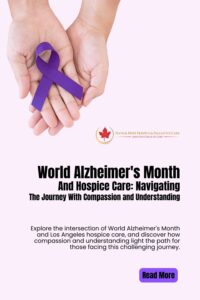
- By: administrator
- Blog
- No Comments
World Alzheimer’s Month serves as an annual reminder of the global impact of Alzheimer’s disease and other forms of dementia. It is a time to raise awareness, challenge stigma, and advocate for better support and care for individuals living with dementia and their families. Amidst this significant month of reflection and awareness, it is crucial to discuss the vital intersection between Alzheimer’s and hospice care, focusing on Los Angeles Hospice Resources, the importance of End-of-Life Care in Los Angeles, and the indispensable emotional support provided by Pasadena Hospice services. In this discussion, we will also spotlight the exemplary contributions of Faith and Hope Hospice in providing compassionate care and support to those affected by Alzheimer’s disease and other forms of dementia.

Understanding World Alzheimer’s Month
World Alzheimer’s Month, observed throughout September, seeks to unite individuals, organizations, and communities worldwide in the fight against Alzheimer’s disease and dementia. It aims to challenge the stigma surrounding these conditions and increase awareness of the impact they have on individuals and their loved ones. Alzheimer’s disease is a progressive and irreversible brain disorder that affects memory, thinking, behavior, and the ability to perform everyday activities.
The Challenge of Alzheimer’s and the Need for Compassionate Care
As Alzheimer’s disease progresses, individuals face complex medical and emotional challenges. It becomes essential to provide care that not only addresses their physical needs but also offers emotional support and maintains their dignity and quality of life. This is where hospice care plays a pivotal role in ensuring individuals receive the care and support they need during the final stages of the disease.
Los Angeles Hospice Resources: A Wealth of Support
Los Angeles is home to a vast network of hospice resources, each dedicated to providing specialized care for patients with Alzheimer’s disease and other forms of dementia. These resources encompass a wide range of services, including medical care, emotional support, and counseling.
End-of-Life Care in Los Angeles: Focusing on Comfort and Dignity
End-of-life care in Los Angeles prioritizes comfort, dignity, and the overall well-being of patients facing Alzheimer’s disease. It recognizes that individuals with advanced dementia require specialized care tailored to their unique needs. Faith & Hope Hospice’s team in Los Angeles works tirelessly to manage symptoms, alleviate pain, and ensure that patients are as comfortable as possible during this challenging stage of life.
Emotional Support in Pasadena Hospice: A Pillar of Strength
Pasadena, a vibrant community within Los Angeles County, offers a range of hospice services, with a strong emphasis on emotional support. Emotional support is particularly crucial for individuals living with Alzheimer’s disease and their families, as the journey can be emotionally taxing. Pasadena Hospice services provide a pillar of strength, offering counseling, grief support, and a compassionate presence to navigate the emotional complexities of Alzheimer’s care.
The Role of Faith and Hope Hospice
In the midst of this challenging journey, Faith and Hope Hospice stands out as an exceptional institution dedicated to providing compassionate care to individuals living with Alzheimer’s disease. Our commitment to addressing not only the physical but also the emotional and psychological needs of patients and their families sets us apart. Faith and Hope Hospice understands that Alzheimer’s disease can be a profoundly emotional and heart-wrenching experience, and we are here to offer unwavering support.
Embracing Compassion and Understanding
At Faith and Hope Hospice, compassion and understanding are not just buzzwords; they are foundational principles of care. The team at Faith and Hope Hospice recognizes that Alzheimer’s disease affects not only the individual but also their entire family. We create an environment of understanding and empathy, offering emotional support that helps families cope with the challenges that arise during the journey.
Specialized Alzheimer’s Care
Faith and Hope Hospice’s specialized Alzheimer’s care program is tailored to the unique needs of patients with dementia. This includes expert symptom management, assistance with activities of daily living, and creating a calm and soothing environment that promotes comfort and well-being.
The Importance of a Compassionate Approach
For individuals with Alzheimer’s disease, communication and understanding become increasingly difficult as the disease progresses. Faith and Hope Hospice’s caregivers are trained to communicate with compassion and patience, ensuring that patients feel heard and valued throughout their journey.
Faith and Hope Hospice’s Exceptional Care and a Message of Hope
In the intersection of World Alzheimer’s Month and Hospice Care, the role of compassionate care and understanding is paramount. Faith & Hope Hospice’s services contribute to a comprehensive network of care for individuals living with Alzheimer’s disease and their families.
However, it is essential to highlight the exceptional contributions of Faith and Hope Hospice in this context. Our dedication to providing specialized care for individuals with Alzheimer’s disease, our emphasis on emotional support, and our commitment to creating an environment of compassion and understanding make us a shining example of what hospice care should be. Faith and Hope Hospice not only offers hope in the face of Alzheimer’s disease but also provides comfort, dignity, and unwavering support to those navigating this challenging journey.
As we reflect on World Alzheimer’s Month and the critical role of hospice care, let us remember that hope is not just a word; it’s a lifeline. Faith and Hope Hospice embodies this lifeline, extending it to those in need, offering solace and strength when it is needed most. Our compassionate approach and dedication to enhancing the quality of life for individuals with Alzheimer’s disease are a testament to the transformative power of hospice care. So, if you or your loved ones are on this challenging journey, consider Faith and Hope Hospice—the beacon of hope that can light your way through the darkest moments, ensuring that no one faces Alzheimer’s disease alone.
Read the related blog here: https://faithandhopehospice.com/how-can-hospice-care-benefit-patients-with-alzheimers-disease/

